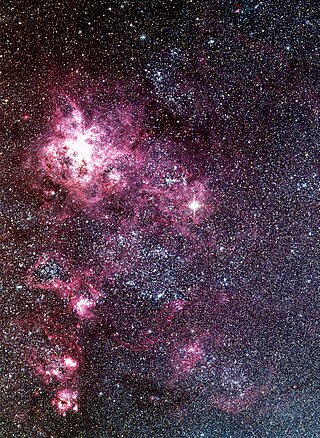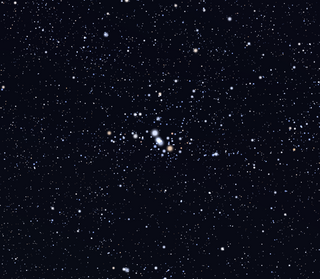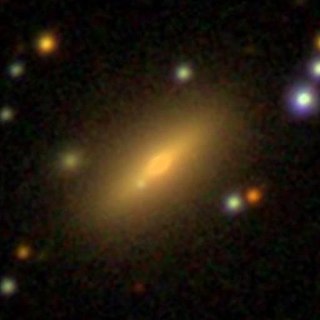
A supernova is a powerful and luminous explosion of a star. A supernova occurs during the last evolutionary stages of a massive star or when a white dwarf is triggered into runaway nuclear fusion. The original object, called the progenitor, either collapses to a neutron star or black hole, or is completely destroyed to form a diffuse nebula. The peak optical luminosity of a supernova can be comparable to that of an entire galaxy before fading over several weeks or months.

SN 1987A was a type II supernova in the Large Magellanic Cloud, a dwarf satellite galaxy of the Milky Way. It occurred approximately 51.4 kiloparsecs from Earth and was the closest observed supernova since Kepler's Supernova. 1987A's light reached Earth on February 23, 1987, and as the earliest supernova discovered that year, was labeled "1987A". Its brightness peaked in May, with an apparent magnitude of about 3.

The Large Magellanic Cloud (LMC) is a satellite galaxy of the Milky Way. At a distance of around 50 kiloparsecs (160 kly), the LMC is the second- or third-closest galaxy to the Milky Way, after the Sagittarius Dwarf Spheroidal (c. 16 kpc (52 kly) away) and the possible dwarf irregular galaxy called the Canis Major Overdensity. Based on the D25 isophote at the B-band (445 nm wavelength of light), the Large Magellanic Cloud is about 9.86 kpc (32.2 kly) across. It is roughly one-hundredth the mass of the Milky Way and is the fourth-largest galaxy in the Local Group, after the Andromeda Galaxy (M31), the Milky Way, and the Triangulum Galaxy (M33).

SN 1604, also known as Kepler's Supernova, Kepler's Nova or Kepler's Star, was a Type Ia supernova that occurred in the Milky Way, in the constellation Ophiuchus. Appearing in 1604, it is the most recent supernova in the Milky Way galaxy to have been unquestionably observed by the naked eye, occurring no farther than 6 kiloparsecs from Earth. Before the adoption of the current naming system for supernovae, it was named for Johannes Kepler, the German astronomer who described it in De Stella Nova.

Cassiopeia A (Cas A) is a supernova remnant (SNR) in the constellation Cassiopeia and the brightest extrasolar radio source in the sky at frequencies above 1 GHz. The supernova occurred approximately 11,000 light-years (3.4 kpc) away within the Milky Way; given the width of the Orion Arm, it lies in the next-nearest arm outwards, the Perseus Arm, about 30 degrees from the Galactic anticenter. The expanding cloud of material left over from the supernova now appears approximately 10 light-years (3 pc) across from Earth's perspective. It has been seen in wavelengths of visible light with amateur telescopes down to 234 mm (9.25 in) with filters.

SN 1572, or B Cassiopeiae, was a supernova of Type Ia in the constellation Cassiopeia, one of eight supernovae visible to the naked eye in historical records. It appeared in early November 1572 and was independently discovered by many individuals.

W49B is a nebula in Westerhout 49 (W49). The nebula is a supernova remnant, probably from a type Ib or Ic supernova that occurred around 1,000 years ago. It may have produced a gamma-ray burst and is thought to have left a black hole remnant.

SN 185 was a transient astronomical event observed in the year AD 185, likely a supernova. The transient occurred in the direction of Alpha Centauri, between the constellations Circinus and Centaurus, centered at RA 14h 43m Dec −62° 30′, in Circinus. This "guest star" was observed by Chinese astronomers in the Book of Later Han (后汉书), and might have been recorded in Roman literature. It remained visible in the night sky for eight months. This is believed to be the first supernova for which records exist.

RX J0852.0−4622 is a supernova remnant. The remnant is located in the southern sky in the constellation Vela ("sail"), and sits inside the much larger and older Vela Supernova Remnant. For this reason, RX J0852.0−4622 is often referred to as Vela Junior.

Tycho G has been proposed as the surviving binary companion star of the SN 1572 supernova event. The star is located about 6,400±1,500 light-years away in the constellation Cassiopeia. It is a subgiant, similar to the Sun in temperature, but more evolved and luminous.

RX J1347.5–1145 is one of the most massive galaxy clusters known discovered in X-rays with ROSAT. As a result, it is also one of the most X-ray-luminous because of its hot gas content. The object resides roughly 5 billion light-years away from the Solar System in the constellation of Virgo. Redshift was noted as z=0.451 with an X-ray luminosity of 1045 ergs s−1 in a paper from 2002. In 2013, one study found eight cases of the same object resulting from the intense gravitational bending of light, which makes it possible to identify a series of remote galaxies located inside the galaxy cluster with calculations from the photometric method between 5.5 and 7.5. That study made use of data from Cluster Lensing and Supernova survey with Hubble (CLASH) as well as other sources. The colors in the galaxy cluster are known to correspond with the level of brightness, or the number of electrons trapped in the examined wavelength range of the cluster, with the colors red, orange, and yellow as high intensity, blue-green and green as medium intensity, and blue and violet as low intensity. It is considered one of the brightest objects that is known by X-ray.

NGC 5746 is a barred spiral galaxy located in the eastern part of the constellation of Virgo. It is a member of the NGC 5746 Group of galaxies, itself one of the Virgo III Groups strung out to the east of the Virgo Supercluster of galaxies.

SN 386 is a probable transient astronomical event in the constellation Sagittarius, which appeared as a "guest star" that was reported by Chinese astronomers in 386 CE.
Laura A. Lopez is an associate professor of astronomy at Ohio State University studying the life cycle of stars. She was awarded the Annie Jump Cannon Award in Astronomy in 2016, which is awarded by the American Astronomical Society (AAS) for outstanding research and promise for future research by a postdoctoral woman researcher.
SN 2013ej is a Type II-P supernova in the nearby spiral galaxy Messier 74. It was discovered by the Lick Observatory Supernova Search on July 25, 2013, with the 0.76 m Katzman Automatic Imaging Telescope, with pre-discovery images having been taken the day before.

NGC 5281 is an open cluster in the constellation Centaurus. It was discovered by Nicolas Louis de Lacaille in 1751-1752 from South Africa, and catalogued it as Lacaille I.7. NGC 5281 is located three and a quarter degrees southwest of Beta Centauri. Under dark skies, it is bright enough to be spotted with naked eye, appearing as a 6th magnitude star.

NGC 1271 is a compact elliptical or lenticular galaxy located about 250 million light-years away in the constellation Perseus. The galaxy was discovered by astronomer Guillaume Bigourdan on November 14, 1884. NGC 1271 is a member of the Perseus Cluster and has a nuclear dust disk in its center. It also has an edge-on, intermediate-scale disk and has a central bulge. Like NGC 1277, NGC 1271 is a candidate "relic galaxy".

NGC 4302 is an edge-on spiral galaxy located about 55 million light-years away in the constellation Coma Berenices. It was discovered by astronomer William Herschel on April 8, 1784 and is a member of the Virgo Cluster.

Henize 70 (N70) is a faint emission nebula and superbubble located in the Large Magellanic Cloud. It is located in the constellation of Dorado.

















